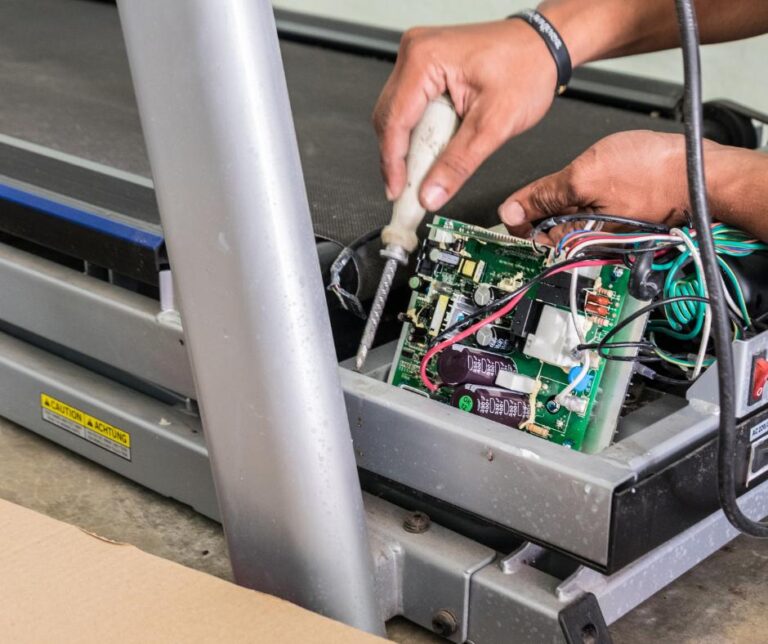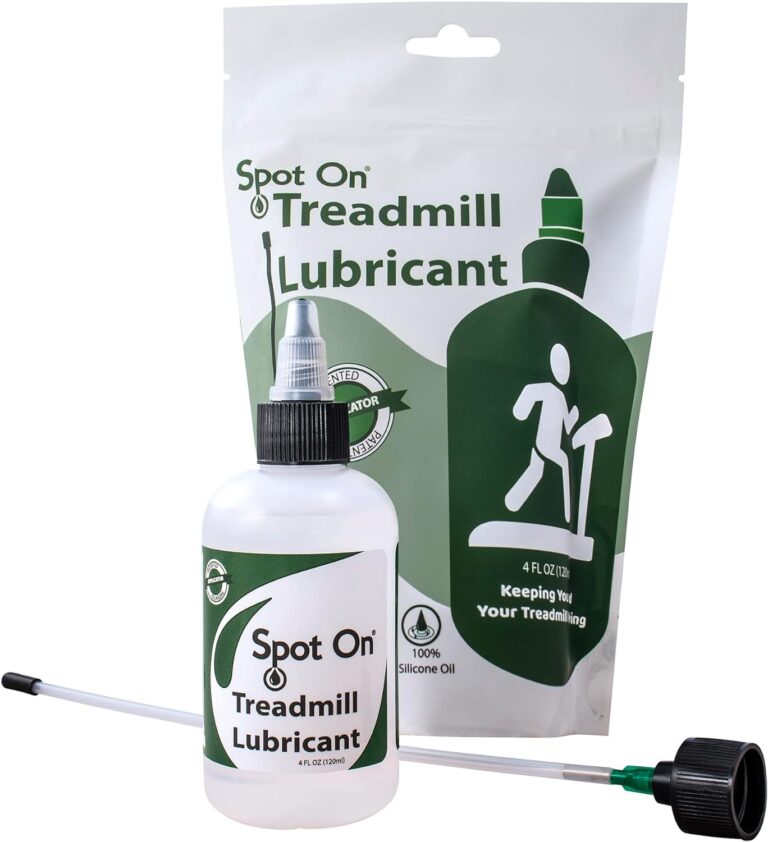Don’t let your workout disturb again due to lubricating issue. In just 4 easy steps, lubricate your treadmill belt at home with our tutorial and guide.
Regular maintenance ensures the long-term functionality and efficiency of every treadmill. One crucial aspect of maintenance is lubrication. Lubricating your treadmill significantly preserves its performance, reduces wear and tear, and expands its lifespan.
Treadmills consist of multiple mechanical parts that are in constant friction when the equipment is in use. The friction can result in overheating and cause the components to wear out over time.
Lubrication works as a protective layer between these parts, reducing friction and preventing overheating, ensuring smooth operation, and reducing the noise produced during the workout.

1. Prepare the Equipment
Before starting, gather all necessary tools and materials. You’ll need a bottle of treadmill lubricant, which can be purchased online or at any fitness equipment store. Ensure that it’s silicone-based, as oil-based lubes can damage the belt. Additionally, you’ll need a clean, dry cloth and a Phillips screwdriver.
2. Clean the Belt and Deck
Firstly, ensure your treadmill is unplugged from the power source to avoid accidental startup. Then, remove the safety key, which is important as it also functions as a fail safe against unexpected turn-ons.
Next, clean the deck surface. Use your dry cloth to remove dust, dirt or debris from the belt and deck. Pay close attention to the areas where the belt meets the deck; this is where most friction occurs during usage.
3. Apply Lubricant
Now comes the actual lubrication process. Check your treadmill’s user manual for specific instructions regarding the process, as some models may require different application methods. If no specific instructions are present, Apply a thin and even layer of silicone-based lubricant underneath the treadmill belt. Do not overapply, as too much lubricant can cause slippage or other issues.
To apply, lift one side of the belt and slowly pour the lubricant onto the deck surface, moving from front to back. Repeat this process on the other side of the belt. After applying, use your cloth to spread the lubricant evenly across the surface.
4. Test Treadmill
Now it’s time to let the treadmill distribute the lubricant evenly. Plug your treadmill back in and insert the safety key. Run the treadmill at a slow speed for around five minutes. This helps to spread the lubricant evenly across the deck’s surface.
Lastly, test your treadmill. Walk on it for a few minutes; you should notice a smoother, quieter operation. If the treadmill is still noisy or the belt seems to stick, it may require another thin layer of lubricant.
How Often You Should Lubricate Your Treadmill
Like any machine, a treadmill needs regular maintenance to ensure smooth and efficient functioning. One crucial aspect of this maintenance is lubrication. The deck and belt of a treadmill are subject to constant friction, which results in wear and tear over time. Lubrication reduces this friction, thereby prolonging the lifespan of these components and the treadmill as a whole.
Several signs can alert you when your treadmill may require lubrication. If the treadmill’s belt slows down or sticks, it indicates that lubrication is needed. Similarly, loud noises emanating from the machine during operation suggest that the internal parts are struggling due to excessive friction. Lastly, the treadmill’s motor can overheat if the machine is not adequately lubricated, increasing energy consumption.
Manuals often suggest specific lubrication schedules based on usage, but as a general rule, it is advisable to lubricate your treadmill every three months or after every 40 hours of use. Remember, proper maintenance, including timely lubrication, is key to getting the most out of your fitness equipment.

Common Issues When You Don’t Lubricate Treadmill
Not lubricating your treadmill can lead to several issues, such as increased strain on the motor, belt displacement or stretching, and even complete breakdown. Regular lubrication can prevent these problems, saving you from expensive repairs or replacement costs.
Lack of Lubrication
One of the primary problems that can arise due to a lack of lubrication is increased friction. When the treadmill belt is not sufficiently lubricated, it creates more resistance when moving against the deck. The resistance can lead to unnecessary strain on the motor, causing it to overheat and possibly fail prematurely. Furthermore, increased wear and tear on the belt can occur, leading to cracking or splitting.
Noise Production
A poorly lubricated treadmill often produces more noise during operation. This increased noise level can be disruptive and indicates that the machine is working harder than necessary, which can lead to motor failure.
Belt Malfunction
Insufficient lubrication can have a direct impact on your workout. The additional friction may cause the belt to slip, creating an unstable running surface and potentially leading to injury. Therefore, regularly lubricating your treadmill is not just about maintaining the equipment; it’s also about ensuring a safe and efficient workout.

Benefits of Regular Lubricating Treadmill
There are countless benefits of treadmill workouts. A well-lubricated treadmill offers a better workout experience. It allows for a smoother run or walk, making your exercise routine more enjoyable and effective. It also contributes to the accuracy of the treadmill’s readings, ensuring you get correct information about your speed, distance travelled, and burned calories.
In addition to extending the lifespan of your treadmill, proper lubrication also enhances its performance and efficiency. One key benefit of lubricating your treadmill is reduced friction between the belt and the deck. This reduction in friction prevents excessive wear and tear on these crucial components, resulting in longer durability and less need for repairs or replacements.
Another significant advantage is increased efficiency. With less friction, the treadmill’s motor doesn’t have to work as hard, saving energy while providing a smoother, more stable workout experience. This efficiency also keeps the motor from overheating, which could lead to significant damage if left unchecked.
Lubricating your treadmill also enhances user safety. A well-lubricated treadmill provides a consistent belt speed, reducing the risk of slips and falls during workouts. Regular lubrication can reduce the treadmill’s noise, making your workout sessions quieter and more enjoyable.

Safety and Precautions
When lubricating a treadmill, it’s crucial to follow specific safety measures to ensure both the machine’s longevity and personal safety. Before starting the process, always unplug the treadmill to avoid electrical hazards. Never apply lubricant to a running treadmill; this could cause slips or falls, lead to an uneven distribution of the lubricant, or potentially damage the treadmill’s motor.
Use only the recommended type and amount of highly rated lubricant for your treadmill model, as using an incorrect or excessive amount can result in damage. Always apply the lubricant evenly across the deck’s surface to ensure optimal performance. Avoid over-lubrication, as it can lead to slippage and potential accidents.
Wear protective gloves when handling lubricants to prevent skin irritation. If any lubricant gets on your skin or eyes, wash it off immediately with warm water. Always keep the lubricant out of reach of children and pets.
Remember to clean any excess lubricant from the treadmill’s surface after application, ensuring no residue remains that could cause slips or falls during use. Finally, allow adequate time for the lubricant to dry before using the treadmill again. By following these safety measures, you can help maintain your treadmill’s efficiency while preventing potential accidents and injuries.
Common Mistakes to Avoid
There are common mistakes that people often make during this process, which can adversely affect the performance of the treadmill or even result in damage:
Treadmill’s Manual
One such mistake is not checking the treadmill’s manual before lubricating. All treadmills are different, and each may require a specific type of lubricant or a particular application method. Using the wrong lubricant could harm the treadmill’s belt and motor, leading to costly repairs or replacement.
Over-Lubricating
Another common error is over-lubricating the treadmill. While it might seem that more lubricant would ensure a smoother run, this is only sometimes the case. Too much lubricant can cause the belt to slip, which could lead to accidents or injuries while using the treadmill. It could also seep into other parts of the treadmill where it isn’t needed, causing it to malfunction over time.
Ignoring Dust
Yet another misstep needs to be addressed to clean the treadmill before applying lubricant. Dirt and dust can build up on the deck and belt of the treadmill, which can mix with the lubricant and decrease its effectiveness. Regularly cleaning your treadmill before lubricating it will ensure that the lubricant works as effectively as possible.
Video Guide and Tutorial
Lubricating your treadmill is an essential part of its upkeep. Just like a car needs oil to run effectively, your treadmill requires regular lubrication to operate at its best. Therefore, make it a part of your regular maintenance routine to lubricate your treadmill for optimal performance and longevity.




